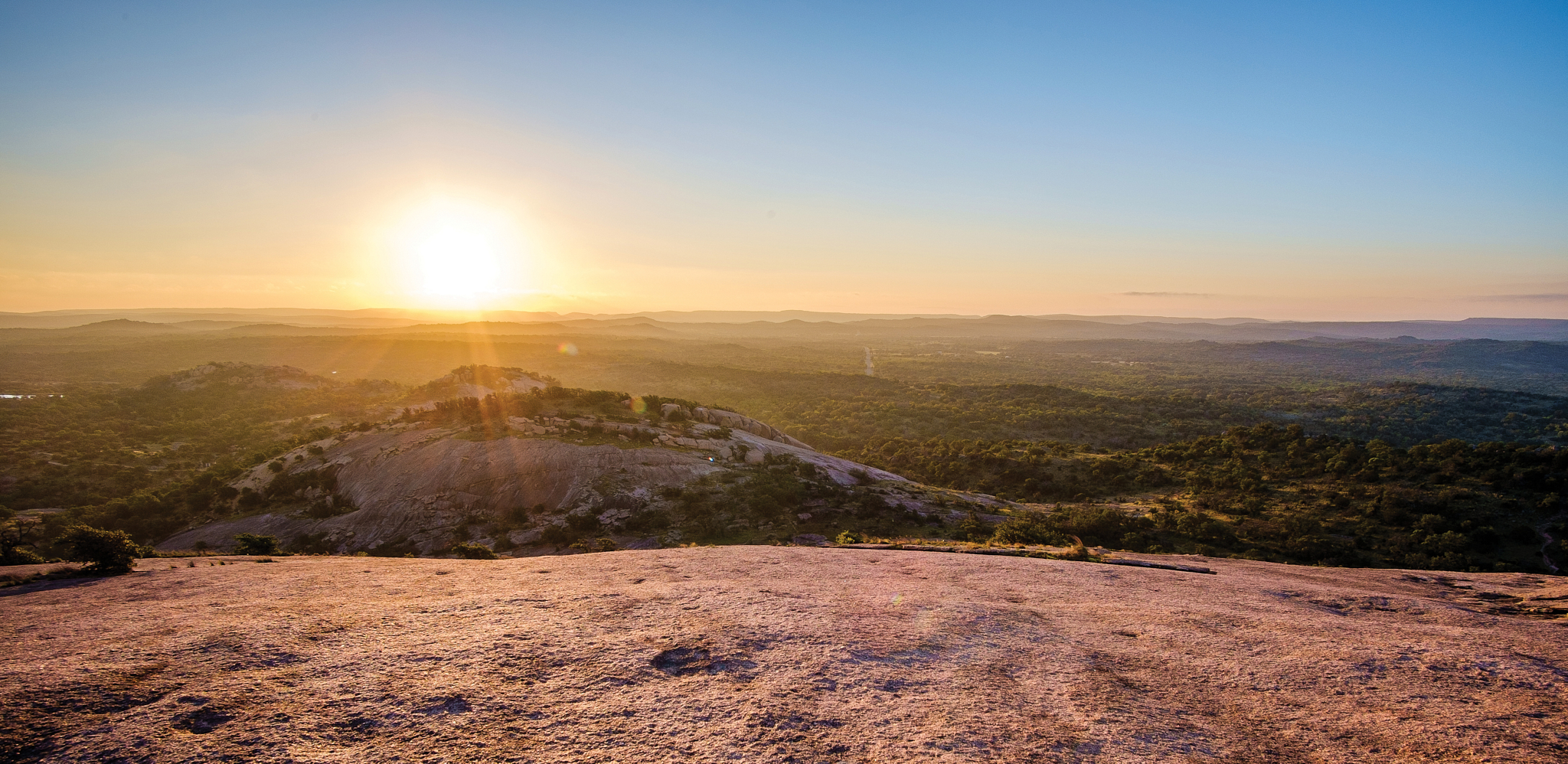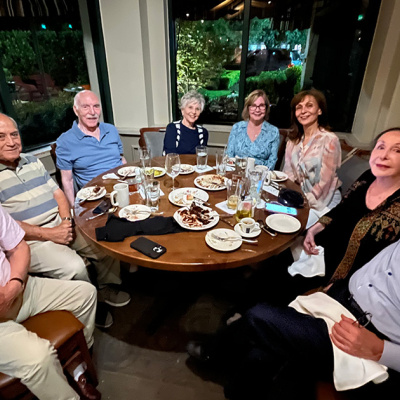God's Country
An excerpt from Armadillos to Ziziphus, a new book of essays from the director of the Biodiversity Center at UT’s College of Natural Sciences.

When I was a college undergraduate, I worked on a research project on the reproductive lives of leopard frogs. One day, I was plotting out the locations of my study sites on a map of Texas, when an older classmate peered over my shoulder to see what I was working on. He knew that I had recently moved to Texas from “back east,” and he wanted to be sure that I understood the importance of the map before us. He traced the Edwards Plateau with his finger, looked at me, and said solemnly, “This is God’s country.” He then pointed to the headwaters of the South Llano River and said, with a twinkle in his eye, “and He lives right there.” The conviction in his voice suggested to me that I should not argue the point. To many who live or visit there, the Texas Hill Country is a special place, to be treated with a certain reverence.
My first memories of the Texas Hill Country—more formally the Edwards Plateau and associated geological regions—date to a fishing trip I took as a very young child, along with my father, brother, and a family friend. My father, a physician with the Air Force at the time, was stationed in San Antonio. He was a viral epidemiologist, and his work on tropical diseases would later take our family to diverse places all over the globe—wherever there were emerging viral epidemics. But my first real connection to the wonders of the Earth’s biodiversity came on that Hill Country fishing trip.
Although I was excited about seeing and catching fish, it was all the spectacular plants and other animals of the Hill Country that truly caught my eye. Not far outside of San Antonio, we spotted a mother skunk, followed by her tiny offspring. My dad stopped the car to let the skunk cross the road, and we all marveled as her mirror-image kits struggled to climb the roadside embankment as they followed their mom. I don’t know if it was their beauty, the commonalities of the interactions of a parent with her offspring, or just the comical nature of the baby skunk movements that captured my imagination and attention. In any case, although that encounter with skunks was some six decades ago, that moment is still seared into my memory. I had no idea how it would happen at the time, but I knew then that somehow, my life was going to be focused on discovering and experiencing the spectacular diversity of life.

After San Antonio, my father’s job carried our family to various parts of tropical Africa and Asia, where I pursued butterflies; watched birds; went fishing; caught lizards, snakes, and frogs; and generally spent every waking moment that I could in the woods, on the water, or in the fields. My parents sometimes worried that I was too distracted by the wonders of the natural world, and more than once my father wondered aloud how I could possibly make a living “chasing lizards.” He gently suggested that perhaps a career in medicine would be a more practical way for me to follow my interest in biology. Nonetheless, my parents encouraged all their children to pursue their interests. My brother started building computers, and my sister became the physician that my father once hoped I would be. I just kept learning everything I could about the spectacular life on our planet, and I never grew out of that childhood fascination.
When it came time to go to college, I gravitated back to the Texas Hill Country, where my love of biodiversity was first ignited. Or, at least as close as I could get to it: I attended Baylor University in Waco, enrolling as a biology major. Even before starting classes in my freshman year, I traveled to Big Bend and then across the Hill Country, and floated down the Frio River at Garner State Park. My first semester, I went to work in the university’s natural history museum, named after the early Texas naturalist and herpetologist John K. Strecker. This afforded me many opportunities for field trips with dedicated naturalists in the biology department, as well as with groups of like-minded fellow students. On my first free weekend, I traveled to Enchanted Rock on the Llano Uplift near Fredericksburg, which was at that time a privately owned campground (it would later become Enchanted Rock State Natural Area). The beauty and diversity of the area resonated with me, and I knew that somehow, for me, this was home. Through college, I spent virtually all my free time traveling through the Hill Country, learning about its plants and animals, floating down its rivers, camping in its parks, and thinking about life.
I met my wife, Ann, at Baylor, and for our first date, I asked her to accompany me to look for frogs in a violent rainstorm. Several days earlier, I’d invited her to come up to my dorm room to listen to my records of frog calls. She turned that initial invitation down, saying that her mother had warned her about people like me, but her roommate accepted my invitation. Ann said later that she was surprised to learn that I had actually played records of frog calls for her roommate. So when it started raining, I called Ann and asked her to meet me in front of her dorm. She jumped into my car to get out of the rain, while protesting that no one should venture out in such weather, and we were on our way. Although she never learned to love frogs as much as I do, she seemed to enjoy my enthusiasm for all things biological. Soon, she was joining me on my forays and camping trips across the Texas Hill Country, and especially to Enchanted Rock.
Ann and I married, and then after graduation from Baylor we moved to the University of Kansas for my graduate school training. After I earned my PhD studying the genetics of frog diversity and evolution, we moved to the University of Miami, where I was first employed as an assistant professor of biology. Ann and I loved scuba diving in the Florida Keys and Caribbean, and I enjoyed the wilds of the Everglades, but it never felt like home. After a few years, when a faculty job in zoology opened up at The University of Texas at Austin, I immediately applied. The next year, we moved to Austin, and I have been on the faculty there ever since. After terms directing the School of Biological Sciences and the Center for Computational Biology and Bioinformatics, I now serve as director of The University of Texas Biodiversity Center, which supports research, education, and public outreach about the Earth’s biodiversity.
Austin is a wonderful place to live, but above all else, to me it is the front porch of the Edwards Plateau. Almost immediately after moving to Austin, Ann and I bought some acreage along a limestone creek near Pedernales Falls State Park in Blanco County, which we named Girraween (an Australian Aboriginal word that means “place of flowers”).
Although I have lived parts of my life on all the world’s inhabited continents, the Texas Hill Country has always felt like home to me. When we had that chance to move back all those years ago, we did not hesitate to do so. Since then, despite offers to live and work in other places, we’ve never been tempted enough to leave. Now, as director of the Biodiversity Center, I get to study, teach, write, and talk to the public about the spectacular diversity of life. It is hard to do that from a better place than the Texas Hill Country.
CREDITS: Daniel Mullins/Shutterstock, Richard A. McMillin/Shutterstock






